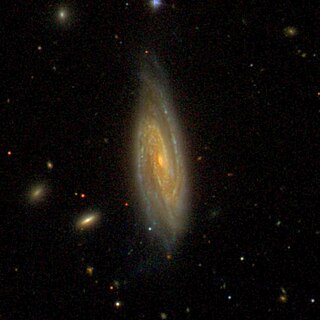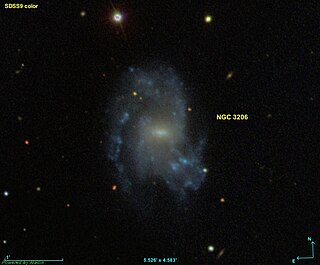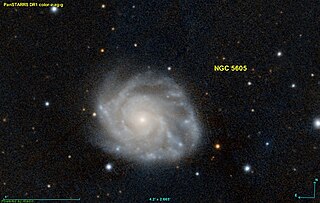
NGC 5490 is a large elliptical galaxy located in the constellation of Boötes. Its velocity relative to the cosmic microwave background is 5,075 ± 22 km/s, which corresponds to a Hubble distance of 244.1 ± 17.1 Mly (74.85 ± 5.25 Mpc). In addition, 13 non-redshift measurements gives a distance of 269.98 ± 15.01 Mly (82.777 ± 4.603 Mpc). NGC 5490 was discovered by the German-British astronomer William Herschel on 14 March 1784.

NGC 4790 is a barred spiral galaxy located in the constellation of Virgo. Its velocity with respect to the cosmic microwave background is 1679 ± 24 km/s, which corresponds to a Hubble distance of 80.8 ± 5.8 Mly (24.76 ± 1.77 Mpc). In addition, six non-redshift measurements give a distance of 74.75 ± 4.07 Mly (22.917 ± 1.249 Mpc). It was discovered on 25 March 1786 by German-British astronomer William Herschel.

NGC 132 is a spiral galaxy in the constellation Cetus. Its velocity with respect to the cosmic microwave background is 5015 ± 25 km/s, which corresponds to a Hubble distance of 241.3 ± 16.9 Mly (73.97 ± 5.19 Mpc). In addition, three non redshift measurements give a distance of 250.81 ± 2.14 Mly (76.900 ± 0.656 Mpc). It was discovered on 25 December 1790 by German-British astronomer William Herschel.

NGC 681 is an intermediate spiral galaxy in the constellation of Cetus, located approximately 66.5 million light-years from Earth.

NGC 673 is an intermediate spiral galaxy in the constellation of Aries. Its velocity with respect to the cosmic microwave background is 4894 ± 20 km/s, which corresponds to a Hubble distance of 235.4 ± 16.5 Mly (72.18 ± 5.06 Mpc). In addition, 31 non redshift measurements give a distance of 206.09 ± 5.54 Mly (63.187 ± 1.699 Mpc). The galaxy was discovered by German-British astronomer William Herschel on 4 September 1786.

NGC 1585 is a spiral galaxy in the constellation of Caelum. Its velocity with respect to the cosmic microwave background is 4,635 ± 31 km/s, which corresponds to a Hubble distance of 68.4 ± 4.8 Mpc. It was discovered by British astronomer John Herschel on 1 December 1837.

NGC 5394 is a barred spiral galaxy located in the constellation Canes Venatici. Its speed relative to the cosmic microwave background is 3,639 ± 14 km/s, which corresponds to a Hubble distance of 53.7 ± 3.8 Mpc. NGC 5394 was discovered by German-British astronomer William Herschel in 1787.

NGC 5875 is a spiral galaxy in the constellation of Boötes. Its velocity with respect to the cosmic microwave background is 3585 ± 6 km/s, which corresponds to a Hubble distance of 52.87 ± 3.70 Mpc. It was discovered by German-British astronomer William Herschel on 1 May 1788.

NGC 958 is a barred spiral galaxy in the constellation of Cetus. Its velocity with respect to the cosmic microwave background is 5505 ± 17 km/s, which corresponds to a Hubble distance of 81.20 ± 5.69 Mpc. However, 19 non-redshift measurements give a distance of 58.93 ± 12.91 Mpc. The galaxy was discovered by German-British astronomer William Herschel on 20 September 1784.

NGC 3557 is a large elliptical galaxy in the constellation of Centaurus. Its velocity with respect to the cosmic microwave background is 3398 ± 23 km/s, which corresponds to a Hubble distance of 50.12 ± 3.53 Mpc. However, 20 non-redshift measurements give a distance of 32.905 ± 2.289. The galaxy was discovered by British astronomer John Herschel on 21 April 1835.

NGC 4375 is a barred spiral galaxy in the constellation of Coma Berenices. Its velocity with respect to the cosmic microwave background is 9325 ± 20 km/s, which corresponds to a Hubble distance of 137.54 ± 9.63 Mpc. However, four non-redshift measurements give a distance of 105.5 Mpc. The galaxy was discovered by German-British astronomer William Herschel on 11 April 1785.

NGC 3052 is an intermediate spiral galaxy in the constellation of Hydra. Its velocity with respect to the cosmic microwave background is 4122 ± 24 km/s, which corresponds to a Hubble distance of 60.79 ± 4.27 Mpc. However, 19 non redshift measurements give a much closer distance of 42.563 ± 6.434 Mpc. The galaxy was discovered by German-British astronomer William Herschel on 7 February 1785.

NGC 2805 is a intermediate spiral galaxy in the constellation of Ursa Major. Its velocity with respect to the cosmic microwave background is 1834 ± 7 km/s, which corresponds to a Hubble distance of 27.05 ± 1.90 Mpc. However, 11 non redshift measurements give a distance of 12.76 ± 11.89 Mpc. The galaxy was discovered by German-British astronomer William Herschel on 2 April 1791.

NGC 3206 is a barred spiral galaxy in the constellation of Ursa Major. Its velocity with respect to the cosmic microwave background is 1309 ± 11 km/s, which corresponds to a Hubble distance of 19.31 ± 1.36 Mpc. In addition, 11 non redshift measurements give a distance of 17.582 ± 1.088 Mpc. The galaxy was discovered by German-British astronomer William Herschel on 8 April 1793.

NGC 735 is a spiral galaxy in the constellation of Triangulum. Its velocity with respect to the cosmic microwave background is 4374 ± 18 km/s, which corresponds to a Hubble distance of 210.4 ± 14.7 Mly (64.52 ± 4.52 Mpc). In addition, eight non redshift measurements give a distance of 227.21 ± 7.99 Mly (69.662 ± 2.449 Mpc). The galaxy was discovered by German-British astronomer William Herschel on 13 September 1784).

NGC 5605 is an intermediate spiral galaxy in the constellation of Libra. Its velocity with respect to the cosmic microwave background is 3635 ± 18 km/s, which corresponds to a Hubble distance of 174.9 ± 12.3 Mly (53.61 ± 3.76 Mpc). In addition, three non redshift measurements give a distance of 194.72 ± 0.68 Mly (59.700 ± 0.208 Mpc). The galaxy was discovered by German-British astronomer William Herschel on 11 May 1784.

NGC 5162 is a very large spiral galaxy in the constellation of Virgo. Its velocity with respect to the cosmic microwave background is 7125 ± 20 km/s, which corresponds to a Hubble distance of 342.8 ± 24.0 Mly (105.09 ± 7.36 Mpc). In addition, 11 non redshift measurements give a distance of 303.71 ± 12.41 Mly (93.118 ± 3.806 Mpc). The galaxy was discovered by German-British astronomer William Herschel on 15 March 1784. It was also observed by Lewis Swift on 19 April 1887, resulting in the galaxy being included twice in the New General Catalogue, as both NGC 5162 and NGC 5174.

NGC 6492 is a spiral galaxy in the constellation of Pavo. Its velocity with respect to the cosmic microwave background is 4351 ± 8 km/s, which corresponds to a Hubble distance of 209.3 ± 14.6 Mly (64.17 ± 4.49 Mpc). In addition, five non redshift measurements give a distance of 183.10 ± 12.28 Mly (56.140 ± 3.766 Mpc). The galaxy was discovered by British astronomer John Herschel on 22 July 1835.

NGC 1493 is a barred spiral galaxy in the constellation of Horologium. Its velocity with respect to the cosmic microwave background is 1004 ± 4 km/s, which corresponds to a Hubble distance of 48.3 ± 3.4 Mly (14.81 ± 1.04 Mpc). In addition, six non redshift measurements give a distance of 35.38 ± 1.71 Mly (10.848 ± 0.525 Mpc). The galaxy was discovered by Scottish astronomer James Dunlop on 2 September 1826.

NGC 4273 is a barred spiral galaxy in the constellation of Virgo. Its velocity with respect to the cosmic microwave background is 2727 ± 24 km/s, which corresponds to a Hubble distance of 131.2 ± 9.3 Mly (40.23 ± 2.84 Mpc). However, 20 non-redshift measurements give a distance of 94.72 ± 4.68 Mly (29.040 ± 1.435 Mpc). It was discovered by German-British astronomer William Herschel on 17 April 1786.




















